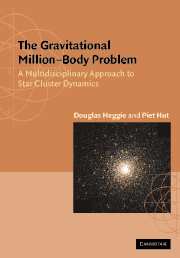Book contents
- Frontmatter
- Contents
- Preface
- PART I INTRODUCTIONS
- PART II THE CONTINUUM LIMIT: N → ∞
- PART III MEAN FIELD DYNAMICS: N = 106
- PART IV MICROPHYSICS: N = 2
- PART V GRAVOTHERMODYNAMICS: N = 106
- PART VI GRAVITATIONAL SCATTERING: N = 3
- 19 Thought Experiments
- 20 Mathematical Three-Body Scattering
- 21 Analytical Approximations
- 22 Laboratory Experiments
- 23 Gravitational Burning and Transmutation
- PART VII PRIMORDIAL BINARIES: N = 4
- PART VIII POST-COLLAPSE EVOLUTION: N = 106
- PART IX STAR CLUSTER ECOLOGY
- Appendix A A Simple N-Body Integrator
- Appendix B Hints to Solution of Problems
- References
- Index
20 - Mathematical Three-Body Scattering
Published online by Cambridge University Press: 05 June 2012
- Frontmatter
- Contents
- Preface
- PART I INTRODUCTIONS
- PART II THE CONTINUUM LIMIT: N → ∞
- PART III MEAN FIELD DYNAMICS: N = 106
- PART IV MICROPHYSICS: N = 2
- PART V GRAVOTHERMODYNAMICS: N = 106
- PART VI GRAVITATIONAL SCATTERING: N = 3
- 19 Thought Experiments
- 20 Mathematical Three-Body Scattering
- 21 Analytical Approximations
- 22 Laboratory Experiments
- 23 Gravitational Burning and Transmutation
- PART VII PRIMORDIAL BINARIES: N = 4
- PART VIII POST-COLLAPSE EVOLUTION: N = 106
- PART IX STAR CLUSTER ECOLOGY
- Appendix A A Simple N-Body Integrator
- Appendix B Hints to Solution of Problems
- References
- Index
Summary
While the last chapter roughed out a picture of what happens in an interaction between a binary star and a third body, there are three very different ways in which the picture can be sharpened. One is to develop approximate analytical results on the outcome of an encounter, and that is successful in various limiting cases, e.g. very distant encounters, very hard binaries, and so on. This is the approach of Chapter 21. To cover the middle ground between these extremes, there is no substitute for computational studies (Chapter 22). In the present chapter, however, we push the analytical methods in the opposite direction, and examine minute corners of parameter space which may be of no conceivable value in applications. The merit of this approach is that rigorous statements become possible, at least in expert hands, and the resulting ideas help to develop our intuition of what can happen in more realistic situations. Our approach is quite informal, and places emphasis on the ideas behind the proofs, without any technical details.
Fractals and chaos
We first turn to resonances, those long-lived but temporarily bound triple systems that often arise in scattering events. Our first aim here is to discuss one situation which makes it particularly clear why the outcome of a resonance depends sensitively on the initial data. We can then argue, at least physically, that the system forgets details of the initial conditions of its formation, and that the breakup is determined (in a statistical sense) only by the quantities which are preserved in the evolution, i.e. energy and angular momentum.
- Type
- Chapter
- Information
- The Gravitational Million–Body ProblemA Multidisciplinary Approach to Star Cluster Dynamics, pp. 189 - 198Publisher: Cambridge University PressPrint publication year: 2003



